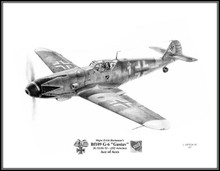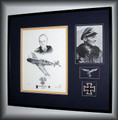 Loading... Please wait...
Loading... Please wait...- Home
- Combat Aircraft/Pencil Drawings ~ Free Shipping
- Messerschmitt Bf109G-6 "Gustav" (Major Erich Hartmann) ~ Free Shipping
Product Description
Print Size 8½" x 11" ~ Unlimited print edition
Like most German aircraft produced in World War II, the Bf 109 G-series was designed to adapt to different operational tasks with greater versatility; larger modifications to fulfil a specific mission task, such as long-range reconnaissance or long-range fighter-bomber, were with "Rüststand" and given a "/R" suffix, smaller modifications on the production line or during overhaul, such as equipment changes, were made with kits of pre-packaged parts known as Umrüst-Bausätze, usually contracted to Umbau and given a "/U" suffix. Field kits known as Rüstsätze were also available but those did not change the aircraft designation. Special high-altitude interceptors with GM-1 nitrous oxide injection high-altitude boost and pressurized cockpits were also produced.
The newly fitted Daimler-Benz DB 605A engine was a development of the DB 601E engine utilized by the preceding Bf 109 F-4; displacement and compression ratio were increased as well as other detail improvements to ease large-scale mass production. Takeoff and emergency power of 1,475 PS (1,455 hp, 1,085 kW) was achieved with 1.42 atm (42.5 inches/6.17 lbs) of boost at 2,800 rpm. The DB 605 suffered from reliability problems during the first year of operation, and this output was initially banned by VT-Anw.Nr.2206, forcing Luftwaffe units to limit maximum power output to 1,310 PS (1,292 hp, 964 kW) at 2,600 rpm and 1.3 atm manifold pressure (38.9 inches/4.4 lbs). The full output was not reinstated until 8 June 1943 when Daimler-Benz issued a technical directive. Up to 1944, the G-series was powered by the 1,475 PS Daimler-Benz DB 605 driving a three-blade VDM 9-12087A variable-pitch propeller with a diameter of 3 m (9.8 ft) with even broader blades than used on the F-series. Pitch control, as on the 109F, was either electro-mechanical (automatic) or manual-electric using a thumb-switch on the throttle lever. From 1944 a new high-altitude propeller with broader blades was introduced, designated VDM 9-12159, and was fitted to high-altitude variants with the DB 605AS or D-series engines.
The early versions of the Bf 109G closely resembled the Bf 109 F-4 and carried the same basic armament; however, as the basic airframe was modified to keep pace with different operational requirements, the basically clean design began to change. From the spring of 1943, the G-series saw the appearance of bulges in the cowling when the 7.92 mm (.312 in) MG 17 were replaced with 13 mm (.51 in) MG 131 machine guns (G-5 onwards) due to the latter's much larger breechblock, and on the wings (due to larger tires), leading to the Bf 109 G-6's nickname "Die Beule" ("The Bulge"). The Bf 109G continued to be improved: new clear-view cockpits, greater firepower in the form of the 30 mm (1.18 in) MK 108 cannon were introduced in late 1943; and a new, enlarged supercharger in the high-altitude DB 605AS engine, a larger vertical stabilizer (G-5 onwards), and MW 50 power boost in 1944.
Erich Hartmann, the world's top scoring fighter ace, claiming 352 victories, flew only the Bf 109G, of which he said:
It was very maneuverable, and it was easy to handle. It speeded up very fast, if you dived a little. And in the acrobatics maneuver, you could spin with the 109, and go very easy out of the spin. The only problems occurred during takeoff. It had a strong engine, and a small, narrow-tread undercarriage. If you took off too fast it would turn [roll] ninety degrees away. We lost a lot of pilots in takeoffs. This illustration is done in the markings of his aircraft.













